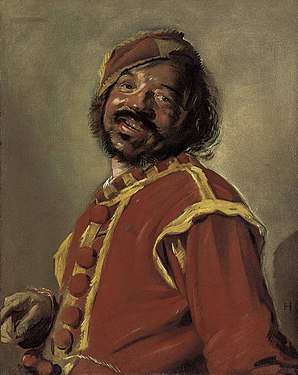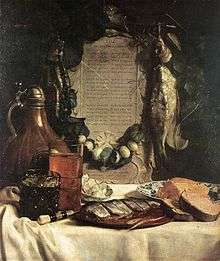Peeckelhaeringh
Peeckelhaeringh, or Pekelharing, refers to an old Dutch word for pickled herring. Today it is best known as a jester by the same name who was the subject of a painting by Frans Hals.
| Peeckelhaeringh | |
|---|---|
| German: 'Der lustige Zecher / Herr Peeckelhaering' | |
 | |
| Artist | Frans Hals |
| Year | 1628 - 1650 |
| Type | Tronie |
| Medium | Oil on canvas |
| Dimensions | 75 cm x 61.5 cm |
| Location | Schloss Wilhelmshöhe, Kassel, Germany |
| Accession | 216 |
The star of 17th-century comic plays, Mr. Peeckelhaering was an actor who was later engraved by the local engraver Jonas Suyderhoef, who accompanied his engraving with a poem declaring that "Mr. Peeckelhaering's wet lips show how he enjoys a fresh mug of beer because his throat is always dry." This painting was documented by Cornelis Hofstede de Groot in 1910, who wrote:
"95. THE MERRY TOPER. B. 97 ; M. 267. Half-length, life size. A laughing man with a brown face is turned half right. His head is slightly inclined to the left ; he looks at the spectator. He has a slight beard and moustache. His rough hair sticks out from beneath a flat red cap with yellow trimming. His costume is also red and yellow. In his left hand he holds a mug with open lid. In the same style as 96 and 98. This picture is represented in two pictures by Jan Steen, Nos. 137 and 446 (see Vol. I.). [Pendant to 123. Compare 99a.] Signed on the right above the mug " f. hals f." ; canvas, 29 1/2 inches by 24 inches. Engraved by J. Suyderhoef as "Monsieur Peeckelhaering." Under the name "Peeckelhaering" pictures are mentioned in the inventories of Henric Bugge, Leyden, 1666 ; Hendrick Huyck, Nymwegen, January 10, 1669 ; and Jan Zeeuw and Marie Bergervis, who died 1690, Amsterdam according to notes by A. Bredius. A copy on canvas, 29 1/2 inches by 26 inches, signed on the right with the monogram was in the sale : Vicomte de Buisseret, Brussels, April 29, 1891, No. 41. In the chief Kassel inventory of 1749, No. 363. In the Kassel Gallery, 1903 catalogue, No. 216."[1]
Pendants
 Hofstede de Groot #95
Hofstede de Groot #95 Hofstede de Groot #96, called "The Mulatto"
Hofstede de Groot #96, called "The Mulatto"
This painting was owned by the Leiden painter Jan Steen who painted it on the background walls of a few of his household scenes, namely The Doctor's Visit, and As the Old Sang, So the Young Pipe. The latter painting was itself based on a popular proverb from the Emblem book "Spiegel van den Ouden ende Nieuwen Tijdt" by Jacob Cats published in 1632 and referred to the habit of birds to echo the pipe, or peeping chirp of their parents.
 Steen painting The Doctor's Visit
Steen painting The Doctor's Visit- Steen painting As the Old Sang, So the Young Pipe
 Engraving by Suyderhoef of Peeckelhaering, with rhyme
Engraving by Suyderhoef of Peeckelhaering, with rhyme Pickled herring in a still life accompanied by a poem called "Lof aan de Pekelharing", by Joseph de Bray
Pickled herring in a still life accompanied by a poem called "Lof aan de Pekelharing", by Joseph de Bray
References
- Hofstede de Groot on "The Merry Toper"; catalog number 95
- Meneer 'Peeckelhaering' by Jonas Suyderhoef in the Rijksmuseum
- Jonas Suyderhoef: son oeuvre gravé, classé et décrit, by Johann Wussin, Labroue & Mertens, 1862
- Jochem Jool, ofte Jalourschen-Pekelharingh, comic play about a jealous husband, by Jan Zoet, 1637